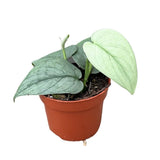55 - 75cm Philodendron Brandtianum Wild Form Silver on Mosspole 17cm Pot House Plant
Philodendron brandtianum, including its wild form, is a stunning aroid known for its ornamental foliage, which makes it a popular choice among houseplant enthusiasts. The leaves of Philodendron brandtianum are heart-shaped, featuring a beautiful olive green color with striking silver or white variegation. This variegation appears as mottled markings across the leaf surface, giving the plant a distinctive and attractive appearance. The "wild form" likely refers to plants that closely resemble those found in their natural habitat, potentially exhibiting more genetic diversity and natural growth patterns than cultivated varieties.
General Care Guide for Philodendron brandtianum (Wild Form)
Lighting: Philodendron brandtianum prefers bright, indirect light. It can tolerate lower light conditions, which may result in slower growth and less variegation. Avoid direct sunlight, which can scorch the leaves.
Watering: Water when the top inch of the soil feels dry to the touch. Philodendron brandtianum likes evenly moist soil but does not tolerate waterlogged conditions, which can lead to root rot. Ensuring good drainage is essential.
Humidity: This plant benefits from high humidity but is quite adaptable and can tolerate average household humidity levels. For optimal growth and to mimic its natural tropical environment, aim for humidity levels above 60%. Increase humidity by misting the plant, using a humidifier, or placing the plant on a pebble tray with water.
Temperature: Prefers warm temperatures between 18°C to 29°C (65°F to 85°F). Protect it from drafts and sudden temperature changes, especially cold drafts in winter.
Soil: Use a well-draining, airy potting mix rich in organic matter. A mix containing peat moss, perlite, and vermiculite is a good option, providing both moisture retention and adequate drainage.
Feeding: Fertilize monthly during the growing season (spring and summer) with a balanced, water-soluble fertilizer diluted to half the recommended strength. Reduce feeding in fall and winter when growth slows.
Repotting: Repot in the spring every 1-2 years or when the plant becomes root-bound. Choose a pot that is one size larger than the current one to encourage growth. This is also a good opportunity to refresh the potting mix.
Pest and Disease Management: Watch out for common pests such as spider mites, mealybugs, and aphids. Treat infestations promptly with insecticidal soap or neem oil. Good cultural practices, such as avoiding overwatering and ensuring proper air circulation, help prevent most diseases.
Philodendron brandtianum's wild form is a resilient and relatively easy-to-care-for plant that adds a touch of the tropical to indoor spaces. Its striking foliage, with unique variegation patterns, makes it a prized addition to any plant collection. By meeting its basic care needs, you can enjoy the lush, vibrant growth of this beautiful philodendron.
Check out our YouTube video to see exactly how we pack for safe delivery.
- Plants are supplied in plastic nursery pots unless stated in the product title.
- Plants are not for consumption unless stated as edible.
- Plant heights can fluctuate +/- 10%.
- Our plants are kept at our tropical nursery in Yorkshire where we maintain an average temperature of 18c.
































